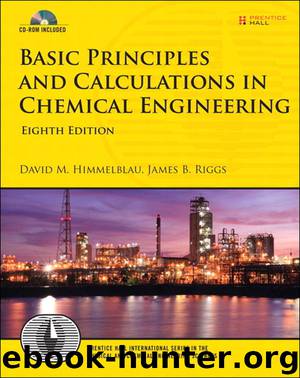Basic Principles and Calculations in Chemical Engineering (Prentice Hall International Series in the Physical and Chemical Engineering Sciences) by David M. Himmelblau & James B. Riggs

Author:David M. Himmelblau & James B. Riggs [Himmelblau, David M.]
Language: eng
Format: azw3
Publisher: Pearson Education
Published: 2012-05-30T16:00:00+00:00
Moles of O2 in with air including excess:
(1 + 0.04)(0.5 mol O2) = 0.52 mol O2
Therefore, 0.52/0.21 = 2.48 mol air enters containing 1.96 mol nN2.
Specifications: 65% of the carbon burns to CO: (0.65)(2) = 1.30.
Basis: 1 mol of H2C2O4 enters
Element material balances:
The results:
nH2O = 1.0; nCO2 = 0.7; nCO = 1.3; nO2 = 1.82; nN2 = 1.96; total mol = 6.78
yH2O = 1 mol H2O/6.78 mol = 0.147
The partial pressure of the water in the product gas (at an assumed atmospheric pressure) determines the dew point of the stack gas; that is, the temperature of saturated steam that equals the partial pressure of the water is equal to the dew point of the product gas:
Download
This site does not store any files on its server. We only index and link to content provided by other sites. Please contact the content providers to delete copyright contents if any and email us, we'll remove relevant links or contents immediately.
Whiskies Galore by Ian Buxton(40332)
Introduction to Aircraft Design (Cambridge Aerospace Series) by John P. Fielding(32338)
Small Unmanned Fixed-wing Aircraft Design by Andrew J. Keane Andras Sobester James P. Scanlan & András Sóbester & James P. Scanlan(32141)
Craft Beer for the Homebrewer by Michael Agnew(17446)
Turbulence by E. J. Noyes(7039)
The Complete Stick Figure Physics Tutorials by Allen Sarah(6638)
Kaplan MCAT General Chemistry Review by Kaplan(6054)
The Thirst by Nesbo Jo(5785)
Bad Blood by John Carreyrou(5769)
Learning SQL by Alan Beaulieu(5412)
Weapons of Math Destruction by Cathy O'Neil(5037)
Man-made Catastrophes and Risk Information Concealment by Dmitry Chernov & Didier Sornette(4736)
iGen by Jean M. Twenge(4702)
Digital Minimalism by Cal Newport;(4542)
Life 3.0: Being Human in the Age of Artificial Intelligence by Tegmark Max(4507)
Audition by Ryu Murakami(4099)
1,001 ASVAB Practice Questions For Dummies by Powers Rod(4039)
Electronic Devices & Circuits by Jacob Millman & Christos C. Halkias(4029)
Pale Blue Dot by Carl Sagan(4001)
